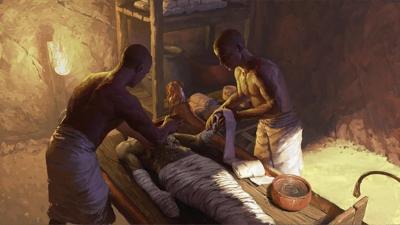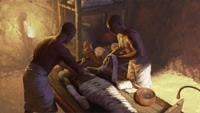NEW YORK (AP) — For thousands of years, ancient Egyptians mummified their dead in the search for eternal life. Now, researchers have used chemistry and an unusual collection of jars to figure out how they did it.
Their study, , is based on a rare archaeological find: An embalming workshop with a trove of pottery around 2,500 years old. Many jars from the site were still inscribed with instructions like “to wash” or “to put on his head.”
By matching the writing on the outside of the vessels with the chemical traces inside, researchers uncovered new details about the “recipes” that helped preserve bodies for thousands of years.
“It’s like a time machine, really,” said Joann Fletcher, an archaeologist at University of York who was not involved with the study. “It’s allowed us to not quite see over the shoulders of the ancient embalmers, but probably as close as we’ll ever get.”
Those recipes showed that embalmers had deep knowledge about what substances would help preserve their dead, said Fletcher, whose partner was a co-author on the study. And they included materials from far-flung parts of the world — meaning Egyptians went to great lengths to make their mummies “as perfect as they could possibly be.”
The workshop — uncovered in 2016 by study author Ramadan Hussein, who passed away last year — is located in the famous burial grounds of Saqqara. Parts of it sit above the surface, but a shaft stretches down to an embalming room and burial chamber underground, where the jars were discovered.
It was in rooms like these where the last phase of the process took place, said Salima Ikram, an Egyptologist at The American University in Cairo who was not involved with the study. After drying out the the body with salts, which probably took place above ground, embalmers would then take the bodies below.
“This was the last phase of your transformation where the secret rites, the religious rites, were being performed,” Ikram said. “People would be chanting spells and hymns while you were being wrapped and resin was being anointed all over your body.”
Experts already had some clues about what substances were used in those final steps, mainly from testing individual mummies and looking at written texts. But a lot of gaps remained, said senior author Philipp Stockhammer, an archaeologist at Ludwig Maximilian University in Germany.
The new finds helped crack the case.
Take the word “antiu,” which shows up in a lot of Egyptian texts but didn't have a direct translation, Stockhammer said. In the new study, scientists found that several jars labeled as “antiu” contained a mixture of different substances — including animal fat, cedar oil and juniper resin.
These substances, along with others found in the jars, have key properties that would help preserve the mummies, said lead author Maxime Rageot, an archaeologist at Germany’s University of Tubingen.
Plant oils — which were used to protect the liver and treat the bandages — could ward off bacteria and fungi, while also improving the smell. Hard materials like beeswax, used on the stomach and skin, could help keep out water and seal the pores.
Some of the substances came from very far away — like dammar and elemi, types of resin that come from the tropical rainforests of Southeast Asia. These results show that ancient Egyptians would trade far and wide to get the most effective materials, the authors said.
“It’s interesting to see the complexity,” Stockhammer said. “Having this global network on the one hand, having all this chemical knowledge on the other side.”
Ikram said an important next step for the research will be to test different parts of actual mummies to see if the same substances show up. And these recipes probably weren't universal — they changed over time and varied between workshops.
Still, the study gives a basis for understanding the past, and can bring us closer to people who lived long ago, she said.
“The ancient Egyptians have been separated from us through time and space, yet we still have this connection," Ikram said. "Human beings all throughout history have been scared of death.”
—�Ĕ�Ĕ
The Associated Press Health and Science Department receives support from the Howard Hughes Medical Institute’s Science and Educational Media Group. The AP is solely responsible for all content.








































